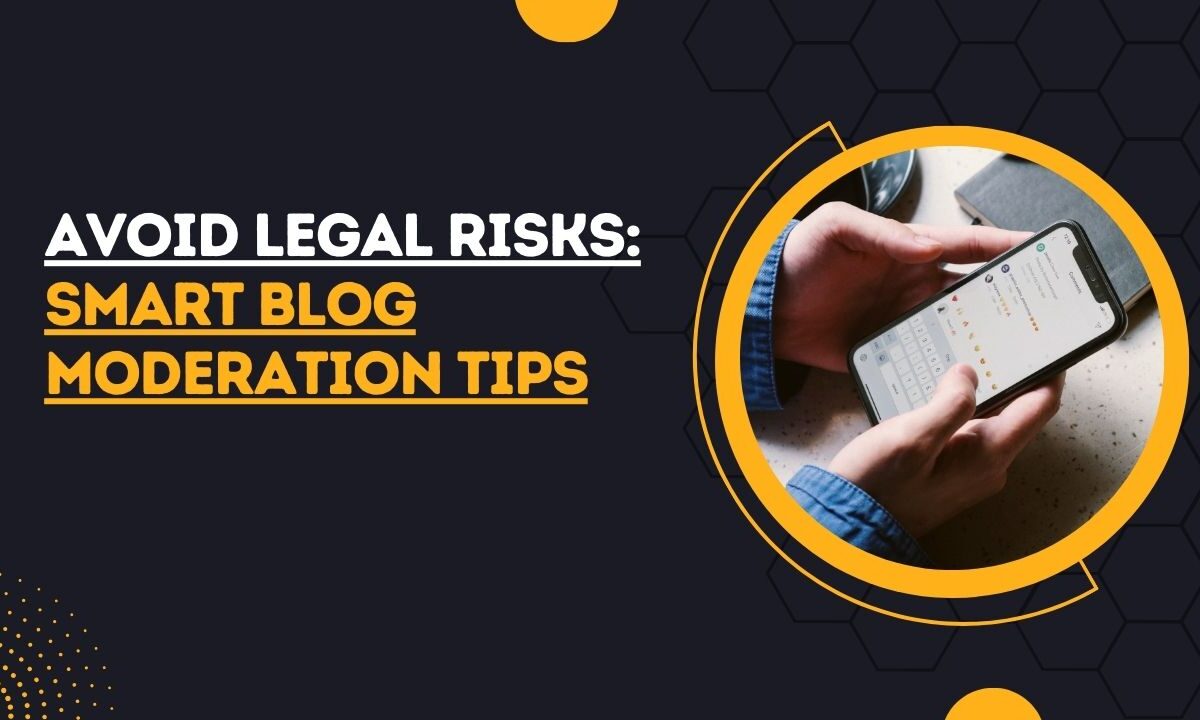Avoid Legal Risks: Smart Blog Moderation Tips
Legal risks in blog moderation are often overlooked, but they can have serious consequences for both bloggers and their communities.
In fact, an article on The Cyber Laws says “...if someone posts a defamatory comment on a blog post, the owner of the blog may be liable for this even if they did not write the comment themselves“.
Picture this: Your blog is flourishing, with readers actively engaging and a lively comment section fueling the conversation. But then, a troll drops in, spreading negativity and potentially crossing the line into harmful territory.
Suddenly, everything you’ve worked for feels at risk.
It’s not just about keeping things friendly; legal risks in blog moderation are real, and mishandling them can lead to defamation suits, copyright violations, or even privacy breaches.
So, how do you navigate this delicate balance?
Let’s explore practical strategies to maintain a thriving community while steering clear of legal pitfalls.
Ready to protect your blog and keep the conversation positive?
Let’s dive in
Why Blog Comment Moderation Matters
Comments on your blog aren’t just a dialogue with your audience; they’re your responsibility.
If unchecked, they can harm your reputation and even drag you into legal battles.
A single defamatory comment or hate-filled rant could spiral into something far worse.
Think of your comments section as the front porch of your house. Would you let just anyone litter it with graffiti?
Moderation isn’t about censorship; it’s about setting boundaries for healthy conversations.
What Are the Legal Risks in Blog Comments?
Legal risks in blog comments aren’t always obvious, but they can be lurking beneath the surface.

Many bloggers assume that user-generated content is harmless, yet issues like defamation, copyright infringement, and hate speech can arise unexpectedly.
Even a seemingly innocent comment can lead to legal consequences if not monitored carefully, making it crucial to understand and manage these risks proactively
Here are a few scenarios to watch out for:
Defamation
Defamation occurs when a comment contains false statements that harm a person’s reputation.
As the blog owner, you could be held liable if you fail to remove such content after being made aware of it.
This includes accusations of illegal activity, unethical behavior, or other harmful claims.
To mitigate this risk, monitor comments regularly and establish clear moderation policies.
Provide a mechanism for individuals to report potentially defamatory content promptly.
Copyright Infringement
Comments that include copyrighted material, such as text, images, or links to pirated content, can put your blog at risk of legal action.
Hosting such material without permission violates copyright laws, even if the commenter is the one who posted it.
To avoid infringement, prohibit users from sharing copyrighted content in your comment policy.
Implement tools or filters to flag potentially infringing material and remove it immediately upon discovery or notification.
Hate Speech
Allowing comments that contain discriminatory, harassing, or threatening language can lead to legal consequences, particularly if the content incites violence or violates anti-hate speech laws.
This applies to speech targeting individuals or groups based on race, religion, gender, or other protected characteristics.
To prevent this, clearly state in your blog’s terms of use that hate speech is prohibited.
Use moderation tools to detect and block such content and act promptly to remove flagged comments.
Data Privacy Violations
When commenters provide personal data, such as names, email addresses, or IP addresses, you are responsible for handling this information in compliance with data privacy laws like GDPR or CCPA.
Failing to protect this data or using it without consent can result in legal penalties.
Ensure your blog’s privacy policy is transparent, specifying how user data is collected, stored, and used.
Use secure systems to manage personal information and allow users to request data removal.
Moderation Liability
As a blog owner, you may be held liable for failing to moderate harmful comments once you’re made aware of them.
While you are not automatically responsible for every comment posted, ignoring problematic content can lead to legal repercussions.
To minimize this risk, implement a clear moderation policy, including guidelines on unacceptable behavior.
Employ tools like comment filters or AI-powered moderation systems and review flagged content promptly to ensure compliance with applicable laws.
Terms of Use Enforcement
If your blog lacks clear and enforceable terms of use for comments, you may struggle to address legal disputes effectively.
Terms of use act as a contract between you and the commenters, outlining what is acceptable and the consequences of violations.
Without these guidelines, users may post harmful content without fear of accountability.
Draft comprehensive terms, display them prominently, and enforce them consistently to avoid legal issues and maintain a respectful commenting environment.
Third-Party Links and Liability
Comments often include links to external sites, which can pose risks if those links lead to malicious, illegal, or infringing content.
As a blog owner, you could be indirectly implicated if users are harmed by such links.
To address this, disable hyperlinks in comments or screen them for safety and legality.
Include a disclaimer in your terms of use stating that you are not responsible for third-party content.
Regularly review comments to ensure compliance and safeguard your reputation.
By addressing these risks, you can foster a safe and legally secure environment for engaging conversations on your blog.
The Balance: Freedom of Speech vs. Legal Responsibility

You might wonder: Isn’t moderating comments infringing on free speech?
The short answer is no.
Freedom of speech has limits, especially when it involves hate speech, defamation, or incitement to violence.
As a blogger, you have a right to protect your platform from harmful content.
To strike this balance, create clear guidelines.
Your readers should know what is acceptable and what isn’t.
This isn’t just good practice—it’s your first shield against potential legal claims.
Smart Tips for Blog Comment Moderation
1. Craft a Comment Policy
Think of your blog comment policy as a rulebook for your blog.
Clearly outline what is acceptable and what isn’t. Include examples of prohibited behaviors, such as hate speech, spam, or personal attacks.
Post this policy visibly, so users are aware of the expectations.
Tip: Use positive language. Instead of saying, “No spamming,” say, “Share relevant and valuable insights.”
2. Pre-Moderate or Post-Moderate Comments
Pre-moderation involves reviewing every comment before it goes live.
It’s time-consuming but ensures your blog stays clean.
Post-moderation allows comments to go live immediately but requires you to remove harmful content afterward.
Choose a method that suits your workload and blog traffic.
| Moderation Style | Pros | Cons |
|---|---|---|
| Pre-Moderation | Complete control over content | Time-intensive |
| Post-Moderation | Quicker interactions | Risk of harmful comments visible |
| Hybrid Approach | Balanced workload | Requires consistent monitoring |
3. Leverage Automated Tools
Technology can be your best ally. Tools like Akismet or Disqus automatically filter spam and flag inappropriate comments.
They act like a bouncer at your blog’s entrance, letting the good in and keeping the bad out.
But remember, no tool is foolproof. Combine automation with occasional manual checks to maintain quality control.
4. Moderate with Empathy
Behind every comment is a real person (trolls included).
Approach moderation with a human touch. Instead of outright deletion, consider leaving a polite explanation for removed comments.
This builds trust and shows transparency.
For instance, if someone posts a borderline offensive comment, respond with: “We value diverse opinions but kindly ask that discussions remain respectful.”
5. Regularly Update Your Moderation Practices
The digital world evolves rapidly.
Yesterday’s harmless comment might be today’s lawsuit trigger.
Stay updated on new regulations, emerging trends, and evolving social norms.
Adapting your approach ensures your blog remains a safe and compliant space.
6. Consult a Legal Professional
If you’re unsure about certain comments or moderation practices, don’t hesitate to seek legal advice.
It’s better to spend a little on consultation than face a costly lawsuit.
Building a Positive Comment Culture
An engaged, respectful community not only enhances the quality of your blog but also minimizes the risk of legal issues and disruptive comments.
By fostering a positive commenting environment, you encourage constructive dialogue while discouraging negativity.
Here are eight strategies to build and maintain a positive comment culture:
Respond Promptly
One of the most effective ways to show your audience that you value their input is by responding quickly to their comments.
Timely replies not only build rapport but also show that you are actively involved in the conversation.
This sense of connection can encourage more people to engage and share their thoughts.
Set aside time each day to review comments and respond to them, especially those that require clarification, feedback, or appreciation.
Highlight Constructive Comments
Feature thoughtful, positive, and relevant comments in your blog posts or social media.
Acknowledging these contributions gives them visibility, encouraging other commenters to engage more thoughtfully.
Highlighting constructive comments can also create a sense of community, where people feel their voices are heard and appreciated.
This practice can shift the focus towards meaningful discussions rather than negativity, fostering an environment of mutual respect.
Reward Regular Contributors
Recognizing active participants can be a powerful motivator.
Consider giving shoutouts or offering incentives like badges, exclusive content, or small prizes for those who consistently contribute in a respectful and insightful manner.
Recognizing their efforts publicly not only rewards the individual but also sets a positive example for others to follow.
Regular contributors feel valued, leading to more consistent engagement and deeper conversations within your blog community.
Establish Clear Community Guidelines
Lay down a set of community guidelines that explain the behavior expected in your blog’s comment section.

These guidelines should address respect, the prohibition of hate speech, defamation, and privacy protection, as well as encourage constructive conversations.
Ensure that the guidelines are visible and easily accessible to everyone who visits your blog.
Clear rules help prevent misunderstandings and set boundaries, making it easier to moderate and maintain a positive environment.
Moderate with Care
Set up a moderation system to keep the comment section clean and free from spam, hate speech, or other disruptive behavior.
Automated tools and manual review can help filter out offensive comments without stifling open discussions.
Keep in mind that moderation should be fair and transparent—informing commenters why their comments were removed or flagged can build trust with your audience.
Avoid heavy-handed tactics that may discourage engagement; instead, focus on creating a balanced environment.
Encourage Positive Topics and Feedback
Steer the conversation towards positive, enriching subjects that align with the values of your blog.
When you post content, encourage your readers to share their experiences, insights, and constructive feedback.
Ask open-ended questions that promote deep discussion and reflection. A well-guided topic can set the tone for the comment section, inviting participants to share their thoughts in a respectful and enriching manner.
This helps avoid negativity and promotes a sense of community and collaboration.
Foster Respectful Disagreements
Disagreements are natural, but they can be an opportunity for growth if handled respectfully.
Encourage your readers to disagree in a constructive manner, using respectful language and offering reasoned arguments. Remind them that differing opinions are welcome as long as they are presented in a thoughtful, non-threatening way.
By normalizing respectful disagreements, you create a safe space where people feel comfortable sharing diverse perspectives without fear of hostility.
Lead by Example
As the blog owner, your behavior sets the tone for the entire community.
Be a model of respect and professionalism in your interactions.
Respond to comments thoughtfully, acknowledge differing opinions, and remain calm in the face of criticism.
When readers see that you maintain a respectful and positive attitude, they are more likely to mirror your behavior.
Your leadership can inspire others to engage in meaningful, uplifting discussions that contribute to a vibrant community culture.
FAQs
1. How can I create a comment policy?
Start by listing behaviors you want to encourage and those you won’t tolerate. Use clear, positive language.
2. What legal risks should I be aware of in blog moderation?
Legal risks in blog moderation include defamation, copyright violations, hate speech, and privacy breaches.
3. Can I delete any comment I dislike?
Yes, but be transparent. Explain why comments were removed to maintain trust.
4. What tools can help with comment moderation?
Tools like Akismet, Disqus, and WordPress’s built-in filters can automate spam and inappropriate comment detection.
5. How can I deal with persistent trolls?
In order to avoid legal risks in blog moderation one needs to deal with persistent trolls. You may need to block repeat offenders and consider IP banning if necessary.
6. Do I need a lawyer for blog moderation?
Not always, but consulting one for extreme cases or policy reviews is a smart move.
7. How often should I review my moderation practices?
Aim for at least quarterly reviews to keep up with evolving legal and digital trends.
Related Posts
Master Blog Moderation with Comment Filters Today
Comment filters are your first line of defense against spam and harmful content. Implementing them helps automatically block inappropriate language, links, or spammy behavior, keeping your comment section clean and manageable.
Essential Tools and Tips for Seamless Blog Moderation
Use moderation tools like Akismet or Disqus to streamline comment management. These tools help identify and filter out unwanted content, making the process quicker and more efficient without losing personal control.
Manual Moderation: The Secret to Perfect Comments
While filters do the heavy lifting, manual moderation ensures quality. Reviewing flagged comments gives you a chance to address any subtle issues and engage meaningfully with your community, fostering positive interactions.
Conclusion
Avoiding legal risks in blog comment moderation isn’t about stifling voices—it’s about creating a safe, respectful space.
By balancing freedom of expression with your legal responsibilities, you can foster a thriving online community.
Start today. Set clear rules, use smart tools, and never underestimate the power of empathetic moderation.
After all, your blog’s reputation is worth it.

